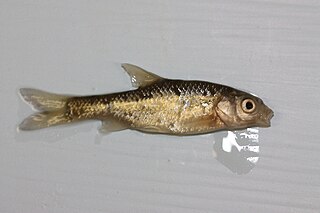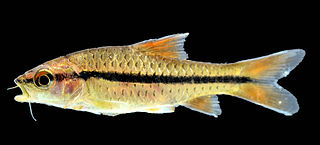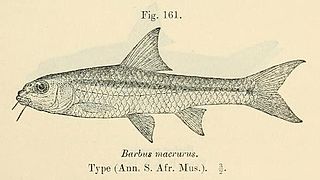The shortfin barb is a species of cyprinid fish native to southern Africa where it occurs in the Sabie-Komati and the Steelpoort-Limpopo river systems. It inhabits well vegetated headwater streams. This species can reach a length of 4.5 centimetres (1.8 in) SL. It can also be found in the aquarium trade.

The African banded barb, Angola barb, blue-barred barb or fire barb is a ray-finned fish species in the family Cyprinidae.
Enteromius arcislongae is a species of ray-finned fish in the family Cyprinidae. It is endemic to Lake Malawi, and is found in Malawi, Mozambique, and Tanzania. Its natural habitats are rivers and freshwater lakes.
Labeobarbus johnstonii is a species of cyprinid fish. It has long been placed in Barbus, the "wastebin genus" for barbs, by default, and this is still being done by the IUCN. However, the species is increasingly being restored to related yellowfish genus Labeobarbus which seems a much more appropriate placement. It is presumably hexaploid like the other yellowfish. The supposed subspecies latirostris of its relative L. intermedius is actually misidentified L. johnstonii.

Enteromius litamba is a ray-finned fish species in the family Cyprinidae. It has long been placed in Barbus, the "wastebin genus" for barbs, by default, and this is still being done by the IUCN. However, the species is increasingly being restored by some taxonomists to the related yellowfish genus Labeobarbus, others place it in the genus Enteromius. It is presumably hexaploid like the other yellowfish.
The east coast barb is a species of cyprinid fish.
The striped robber is a species of fish in the family Alestidae. It is found in Angola, Botswana, Malawi, Mozambique, Namibia, South Africa, Zambia, and Zimbabwe. Its natural habitats are rivers and inland deltas.

Hamilton's barb, also known as the plump barb, is a species of ray-finned fish in the genus Enteromius.

The chubbyhead barb is a species of freshwater ray-finned fish in the genus Enteromius. The fish is found throughout South Africa in a variety of aquatic environments. The species is notable for its two breeding seasons, which allows it to flourish despite a short lifespan.
The Barotse barb is a species of ray-finned fish in the genus Enteromius from the southern Congo Basin, Zambezi, Okavango, Cunene and Kafue.
The sickle barb is a species of ray-finned fish in the genus Enteromius. it gets its common name from the sickle shaped anal fin of mature males, they are normally a translucent brown colour with a spot on the caudal peduncle but in breeding condition the males take on a rosy hue. It is a common and widespread species of swamps and shallow waters, including floodplains, in central Africa from the Congo Basin to the Zambezi. It is harvested commercially for food and for the aquarium trade and in some areas, such as Katanga, pollution may be a threat but it is a common and widespread small fish and is not considered to be globally threatened.

Spotscale barb is a species of ray-finned fish in the genus Enteromius which occurs in western central Africa from Cameroon south to Angola.

Jae barb or Dja barb,, is a species of cyprinid fish which like other sub-Saharan "barbs" was formerly placed in the genus Barbus, it has now been reallocated to Enteromius.
The broadband barb is a species of cyprinid fish in the genus Enteromius. It is found in Lake Malawi and the lower Zambezi, Pungwe River and Buzi River. The broadband barb is exploited for human consumption and for the aquarium trade.
The Yellow barb is a species of cyprinid fish in the genus Enteromius.

The papermouth, also known as the silverfish is a species of ray-finned fish in the genus Enteromius.
Sidespot barb is a species of cyprinid fish in the genus Enteromius. It has a disjunct distribution with the northern population in the upper Zambezi, Kafue, and upper Congo River systems in Zambia and Democratic Republic of the Congo, while the southern population is found in the tributaries of the Limpopo River and Steelpoort River. The southern population may be a separate species.

The slender barb or longbeard barb is a species of ray-finned fish in the genus Enteromius which has a wide distribution from the Democratic Republic of the Congo to South Africa.

Enteromius is a genus of small to medium-sized cyprinid fish native to tropical Africa. Most species were placed in the genus Barbus.
The barred minnow is a species of cyprinid fish found in river systems from the Democratic Republic of Congo, south to Namibia, Zimbabwe and far northern areas of South Africa.









